Subscriber Benefit
As a subscriber you can listen to articles at work, in the car, or while you work out. Subscribe NowWhen Norman and Amy Kanis started their antique shop in 1980, they didn’t realize they were on their way to becoming local pioneers in a business niche that would still be around more than three decades later.
Drawn by the detail and craftsmanship architects and builders used in historic homes, the couple included a growing mix of light fixtures, mantels, doors, woodwork, pillars, hardware and stained glass along with traditional antiques at their shop, then known as Colonial Antiques.
Soon, such pieces became the bread-and-butter of the business, which is now called Architectural Antiques of Indianapolis.
Antique shops were more plentiful then, but none in the area focused on architectural pieces.
“A lot of antique dealers had a piece or two, a few lights, or a door or mantel or two, but there was nobody at the time that focused on architectural antiques,” said Norman Kanis. “We were always interested in those types of things and they became the biggest part of our business.”
The Kanis family kept the architectural salvage niche mostly to itself locally until the 1990s, when a new group of players emerged along with the residential building boom.
Several of those competitors are still around in one form or another after evolving and adapting to economic and construction industry trends. And they’re optimistic about the future of the business after a long stretch of struggles brought on by the recession.
The following is a look at those businesses:
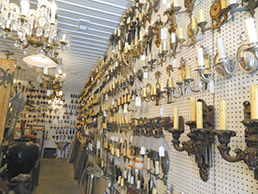 (IBJ Photo/Jeff Newman)
(IBJ Photo/Jeff Newman)
Architectural Antiques of Indianapolis
5000 W. 96th St. • 873-2727
www.facebook.com/ArchitecturalAntiquesofIndianapolis
Norman and Amy Kanis founded their business at 5000 W. 96th St. on their family farm shortly after getting married. They’ve since filled three buildings totaling about 10,000 square feet with artifacts. And that doesn’t include the items stored outdoors and in trailers, Amy pointed out.
The company has three full-time employees in addition to Norman and Amy, including their 26-year-old son, Gregory, and 27-year-old nephew, Jonathan Bonnet.
The 5,400-square-foot, 10-year-old showroom contains a stunning mix of lights, doors, columns, stained glass, cabinets, hutches, fireplace mantels, door hardware and bathroom fixtures, all presented with a remarkable lack of clutter.
“We’ve still got piles of stuff in the other buildings for people to rummage through, but people seem to really like the organization we’ve done in the big building,” Norman said.
The “thrill of the hunt” is what got Norman, 58, interested in historic items to begin with, but his time spent picking declined over the years as his inventory grew. Most of his time now is spent in the shop, working with clients and processing inventory.
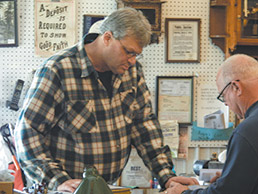 (IBJ Photo/Jeff Newman)
(IBJ Photo/Jeff Newman)Pickers and customers often bring items directly to him, and he still does a fair amount of hunting in the summer. Increasingly, it can be “a struggle to find unusual and quality items,” he said.
About 80 percent of the shop’s inventory comes from Indiana and the rest from neighboring states. The business looks for items in good, almost-original condition because it does little restoration, except for its specialty of lighting fixtures.
The shop has not embraced the Internet for direct sales, but is revamping its website to allow for commerce.
“I realize the importance of the Web, but I’ve always preferred to deal with people walking in the door, face to face,” Norman said. “The Internet is something we are working on.”
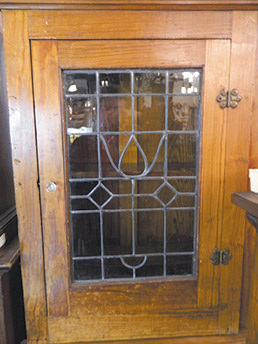 (IBJ Photo/Jeff Newman)
(IBJ Photo/Jeff Newman)Architectural Antiques does a fair amount of business with remodelers and resellers, but an estimated 70 percent comes from end users—individuals remodeling or decorating their homes. That client mix made it tough for the company during the recession, when local homebuilding ground to a fraction of its pace in the 1990s and early 2000s.
“Even though we sell a lot to people doing restorations, the biggest part of our business comes from new construction, so when that dropped off, it hurt a lot,” said Norman, who saw sales fall by half at the height of the recession.
Click here to see more architectural finds.
“I feel like this is what I’ll be doing the rest of my life,” he said. “But there was a time during the recession when the thought [that the business wouldn’t survive] did creep into my mind. It was tough for a while, but it made you work to become a better business.
“Things seem to be steadily improving, not by a huge rate, but incrementally we’re seeing a difference.”
Competition from similar shops has heated up over the years, Norman said, but he thinks he loses far more sales to companies making new products.
“There are a lot more reproductions, so people have the choice of buying the real thing or buying something made in China,” he said. “Of course, the quality is not the same. A lot of the things today are made with planned obsolescence. When people made stuff 80 years ago, they made it the best they could. That’s why it’s still around today.”
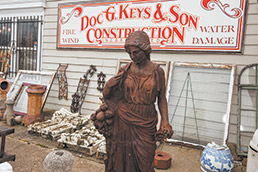 (IBJ Photo/Eric Learned)
(IBJ Photo/Eric Learned)
Doc’s Architectural Salvage & Reclamation Services
1325 W. 30th St. • 924-3997
http://www.docsarchitecturalsalvage.com
https://www.facebook.com/DocsArchSalvage
When it comes to size and sheer volume of stuff, Doc’s is by far the biggest player in town.
Its seven-acre site and 40,000-square-foot warehouse and showroom at 1325 W. 30th St. has tens of thousands of construction-salvage items in condition ranging from near-junk to pristine. Customers have been known to get lost in the maze-like warehouse as they weave through room after room of items.
Doc G. Keys began accumulating architectural salvage items over the years as a hobby while working at the family building-restoration company, which was started in 1952. In the late 1990s, he rented a booth at Midland Arts & Antiques Market to sell his wares, but quickly ran out of space and moved to the construction company’s site on West 30th Street, taking a small portion of the space.
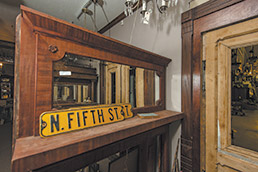 (IBJ Photo/Eric Learned)
(IBJ Photo/Eric Learned)He officially launched the business in 2000 as White River Architectural Salvage & Antiques, but the business changed names in 2007 as part of a divorce agreement. Keys has since closed the construction business and moved to Springfield, Tenn., near Nashville, to open another Doc’s location.
Left behind to run the Indianapolis business is Keys’ 31-year-old son, Doc C. Keys, or “Little Doc,” who grew up working in the family construction business. He oversees five full-time employees.
Because of its size, Doc’s is able to deal in inventory not found at many shops, including huge items such as back bars and front bars. The inventory list includes hundreds of doors, bathtubs, sinks, shutters, tin ceiling tiles, lintels, corbels, sconces, fencing, fireplace mantels, wood flooring, hardware, heat registers, mirrors, reclaimed lumber, hutches and sideboards.
Unlike other shops, Doc’s restores many of its products and will strip and refinish furniture for customers.
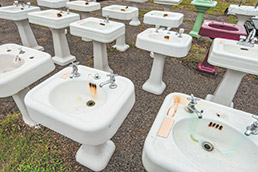 (IBJ Photo/Eric Learned)
(IBJ Photo/Eric Learned)“Honestly, when my father started doing this, a lot of people just thought he was buying crap, and they didn’t understand it,” said Keys. “They thought he was crazy, like a hoarder.”
But the business took off quickly as the residential construction business boomed in the early and middle part of last decade. Meanwhile, a growing number of home-improvement-related TV shows sparked a huge interest in architectural products.
Doc’s built its inventory by traveling the Midwest and buying truckloads of items, including whole houses in some cases. The store also works with 10 to 15 pickers on a regular basis.
The recession hurt business, but it made it easier to stock up on inventory as thousands of homes were lost to foreclosure.
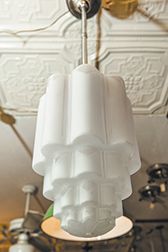 (IBJ Photo/Eric Learned)
(IBJ Photo/Eric Learned)The store was able to survive the downturn by turning to the Internet, where Doc’s now makes a big majority of its sales. That was especially the case this winter, when walk-up business was almost non-existent at times during the brutal weather.
The company operates an eBay store where it offers hundreds of items.
“If we weren’t on the Internet, we would not be out of construction,” Keys said. “The Internet is really carrying us.”
Business has been improving slowly since the recession, especially now that sales of higher-end houses have improved.
“It’s not like it was six, seven years ago, but it’s picked up,” Keys said. “Wealthier people are buying houses and those are the types of customers who buy our products.”
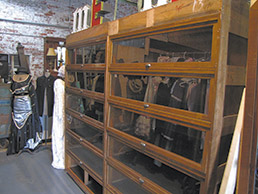 (IBJ Photo/Jeff Newman)
(IBJ Photo/Jeff Newman)
Reclaimed Vintage Industrial
24 S. Shelby St. • 403-1124, 224-5755
www.facebook.com/ReclaimedVintageIndustrial
Greg Neff has been deconstructing buildings for the better part of three decades and has a passion for saving old construction materials and architectural pieces. But he isn’t a big fan of the word “salvage.”
“We prefer the term reclamation contractor over salvage,” said Neff, who runs Reclaimed Vintage Industrial with partner Patsy Gross. “For years, I’ve thought salvage sounded too much like ‘Sanford & Son’.”
Reclamation of building materials is a relatively new concept in the United States, but has been common practice in Europe for centuries, he said. Neff recalls a European man once telling him, “My son picks up bricks like your parents used to pick up pop bottles.”
“Reclamation is 200 to 300 years old in Europe; there’s not anything that’s not saved there,” said Neff, who’s doing his best to spread the practice in central Indiana.
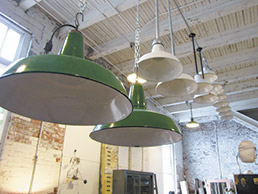 (IBJ Photo/Jeff Newman)
(IBJ Photo/Jeff Newman)A carpenter by training, Neff, 48, spent his early career taking apart barns and other buildings near his hometown of Fort Wayne. He brought a lot of reclaimed materials with him when he moved to Indianapolis in the early 1990s and began working with Tim Harmon (see page 19A) and Doc Keys, among other jobs.
“I’ve been in the trades, and it’s always given me an advantage because I know how things are built, so I know how they come apart,” Neff said.
He founded his own company, America Reclaimed LLC, in 2008 and opened a shop at 630 Virginia Ave. called Reclaimed!, where he and Gross pedaled items saved from deconstruction jobs.
In late 2012, after changing its name to Reclaimed Vintage Industrial, the business moved into a much bigger space at 24 S. Shelby St., in a 110-year-old building that once was a bottling plant for Home Brewing Co., a beer maker that went out of business on the eve of Prohibition.
Unlike most of its competitors, Reclaimed carries an inventory heavy on items from commercial rather than residential buildings, including pendant lights, windows, doors, barn-door hinges, sign letters, tiles and even a 20-foot-long skylight once used in the lobby of the Victoria Centre downtown on East Washington Street.
Among the inventory are pieces reclaimed before the demolition of the Indianapolis International Airport terminal and the Sherman Park RCA plant.
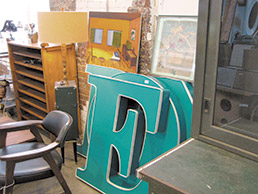 (IBJ Photo/Eric Learned)
(IBJ Photo/Eric Learned)Neff and Gross are the company’s only employees, but they hire on family and friends as needed to help them with reclamation jobs.
About 50 percent of Reclaimed’s sales come via the Internet. The company uses its own website as well as eBay, Facebook and even Craig’s List to drive sales.
Neff said he likes the industrial trend because he’d “rather be greasy these days than deal with the possibility of lead paint.” But the shop carries a mix of merchandise and is always ready to adjust to trends. Neff and Gross still handle residential reclamation projects when the property is right.
Mid-century modern items are still going strong, Gross said, and they mix well with industrial stuff.
“The trade is really driven by what’s popular and, around here, industrial is doing really well,” said Gross, who worked in warehousing for Caterpillar before getting involved in the reclamation business full time. “I think it’s going to be a strong phase for a while because everybody’s loving the look.”•
Tim & Julie’s Another Fine Mess
2901 E. 10th St. • (239) 627-0498
www.facebook.com/pagesTim-Julies-Another-Fine-Mess/332369673510731
Tim Harmon is well-known in the residential reclamation field as the co-founder of Tim & Billy’s Salvage, which received national media attention near the turn of the century thanks to its huge stock of old, high-flow toilets and a willingness to embrace the World Wide Web in the early days of e-commerce.
Julie Crow carved her own niche in the reuse trade by running the Modern Times vintage clothing store in Broad Ripple from 1980 to 1995.
The pair got together in late 2012 to open Tim & Julie’s Another Fine Mess in a 6,000-square-foot building at 2901 E. 10th St. that was built in the early 1900s to house a hardware store.
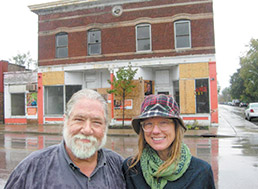 (Submitted photo)
(Submitted photo)The store contains a wide array of reclaimed construction items, furniture and vintage pieces big and small.
Harmon was a carpenter who began collecting old building materials while doing renovations locally in the 1980s. He eventually filled up his house, his porch, a garage and a rented booth at an antique mall before opening Tim & Billy’s in 1991 with William Vant Woud.
The business then became Tim & Avi’s from 1998 to 2006 after Tim’s son replaced his original partner.
It operated for years in a 31,000-square-feet building on an acre of property near 10th Street and Central Avenue, then finished its run in a 10,000-square-foot building at 25th and Central.
Harmon decided to retire from the business in 2006 to concentrate on home preservations and running rental properties.
The timing was good, because Harmon avoided the struggle of running a retail business in the recession. Eventually, though, he found he was “spending money way too fast,” so he decided to make a return with the help of Crow.
Harmon sold much of his inventory before he closed Tim & Avi’s, but kept a lot in storage, including 500 toilet-tank lids. That left him with plenty of items for Another Fine Mess.
“Business is as good as it ever was,” Harmon said. “We really walked back into the business right where I left off.”
The couple tries to do one reclamation job a week to bring in more stock. They stick to Indiana for deconstruction work in pursuit of old lumber, hardware, flooring, trim and any other materials that will sell.
They’ve had good luck targeting farmhouses near rural towns.
“Small towns still have great stuff that hasn’t been boogered up,” Harmon said.
Among their recent finds were two pickup truckloads of painted gymnasium flooring and 26 oak church pews.
Harmon said the big difference in the business is the amount of competition, not just from other salvage businesses but from retailers selling reproductions.
The store’s customer mix still consists of people restoring old houses who seek lumber, woodwork and flooring, and those who want old doors, lights, hardware, doorknobs and heat registers for new houses.
The store also attracts downtown apartment dwellers, who like to repurpose salvage for decorating and art pieces.
Harmon and Crow, both 61, still rely on rental properties to make ends meet, but the shop provides “lunch money” and keeps them busy.
“We think the business is a real, viable, profitable, important, green business,” Harmon said. “We love saving all this stuff. Reuse is so much better for everybody than recycling, so we’re really proud of what we do and love what we do.”
During his retirement, Harmon realized how much he missed the business.
“We tell customers all the time, ‘Come back, we’re gonna be here until we die,’” he said. “We’re not going to retire. Julie and I have both retired in the past. We’re back at work and we really enjoy what we’re doing.”•
Please enable JavaScript to view this content.
